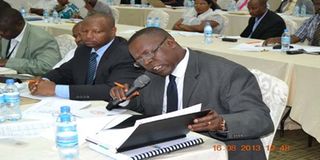$300m credit to revive Dar-Isaka railway services

Rail Assets Holding Company managing director Benhadard Tito speaks in a past event. PHOTO | FILE
What you need to know:
Our reporter Veneranda Sumila interviewed Rail Assets Holding Company managing director Benhadard Tito on what is being done to revive the railway
INTERVIEW. The central railway is in a bad condition. Heavy cargo that used to be carried by the railway is now hauled by trucks, destroying roads. Our reporter Veneranda Sumila interviewed Rail Assets Holding Company managing director Benhadard Tito on what is being done to revive the railway
For years there have been plans to improve the Tanzania Railways Limited which include urgent infrastructure repairs and having a clear marketing strategy. What progress has so far been made?
Let me make clear that Rahco is responsible for infrastructure while the Tanzania Railway Limited is responsible for railway operations.
It is true that there are plans for repairing and upgrading rail infrastructure. They include upgrading track to 80lb/yard [heavier crane rail], rehabilitating bridges and elevating the axle load to 25 tonnes/axle. There are also plans to rehabilitate and upgrade the signal and telecommunications system.
Out of 2707 kms of tracks, 528 kms have so far been relayed with 80 lb/yd whereas other 508 kms are expected to be finished within the next five years under Intermodal and Rail Development Project.
About 220 bridges are now having 25 tonnes per axle out of 2,194 bridges. Within the next five years we are set to rehabilitate 144 bridges that are either very weak [category — E] or have an axle load of less than 25t/axle. Under local funds/budget, three bridges have been re-constructed to higher capacity.
Various dialogues are going on with international donors as well as private international investors to partner with the government to upgrade the railway network.
I am aware that there have been talks with the World Bank under a project named Intermodal and Rail Development Project to have a loan of $200 million for reviving railway services between Dar es Salaam and Isaka. What is the progress so far made?
The credit has been revised to $300 million to be provided over five years from 2014/15. Preparations have been going on since last year and to date a field assessment, a scope definition, a packaging of contracts and a budget preparation have been finalised.
Final negotiations between the government and the World Bank on the financing agreement and project document was concluded on March 7, 2014 and the signing for the financial agreement is scheduled later this month.
In financial years 2011/12 and 2012/13 Rahco planned to upgrade 120 kms of fibre optic cable but none was upgraded. What was the reason for the failure?
The 120 kms of fibre cable were planned to be upgraded in financial year 2011/12 was not done due to budgetary constraints.
Since 2010 your capital expenditure has been less than 30 per cent of your targets. For example in the financial year 2010/11 you targeted to spend Sh127 billion, but you ended up spending only 30.1 billion.
In 2011/12 you targeted to spend Sh141 billion but you only spent Sh30.9 billion, in 2012/13 you targeted Sh146 billion but ended up spending only Sh26.2 billion. What are the reasons for the trend and how has the situation affected your performance?
The reason for capital expenditure to be less than 30 per cent since 2010 is government budget constraints. This affects us as Rahco fails to implement its development projects as planned thus rail transport infrastructure is compromised.
What are your plans to construct rail lines for commuter train services in Dar es Salaam?
We have a plan to construct new rail routes from the city central station to Chamazi via Kurasini and Mbagala, Kibaha via Ubungo, Kerege via Bunju and to Pugu via the airport.
The procurement process for the consultant to undertake the feasibility study and preliminary design for commuter train services in Dar es Salaam and neighbouring towns is going on, with the submission of proposals from bidders set on April 30, 2014. On completion of the study, we shall start sourcing financing of the project. The actual time for starting and completing the construction will depend on the availability of funds.
As per section 18 of the Railway Act, Rahco is required to establish and operate a separate fund to be known as the Railway Infrastructure Fund. How have you fared with the initiative?
The procurement process for a consultant to study and prepare a proposal on establishing the fund was undertaken, but was suspended to await progress of an initiative to establish the National Transport Infrastructure Fund, or NTIF, proposed under the Big Results Now programme. When the NTIF is established, there won’t be any need to have the Railway Infrastructure Fund.
Does TRL pay concession fees and other statutory obligations as agreed?
TRL is not paying any concession fees.
What other challenges do you experience in your daily operations and how can they be solved?
The challenges we experience include insufficient funds to meet the targets, theft and vandalism of railways.
infrastructure such as rails and slippers and encroachment of railway plots. Because of financial problems, it has been difficult to protect and construct barriers and most of our assets remain idle due to the deterioration and shortage of rolling stock. Another challenge is the deterioration of the rail infrastructure.
The challenges can be overcome through enhanced financing and development of railway projects, through private-public partnerships and loans.
To overcome the challenges, all projects have to be completed. They include the feasibility study and detail designs to enable Rahco and the government to have all facts and designs required during negotiations and mobilisation of resources from development partners, financial institutions and the private sector.




